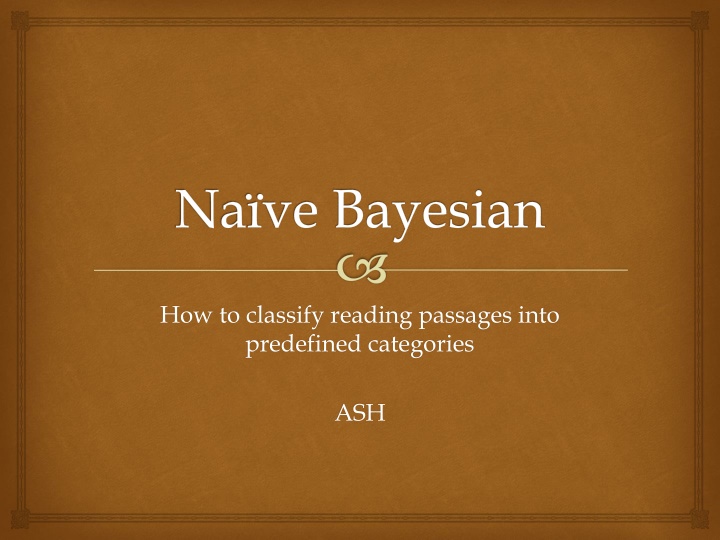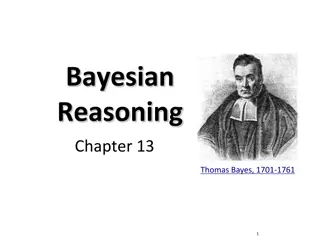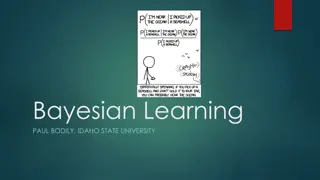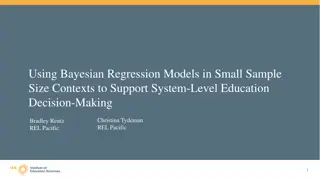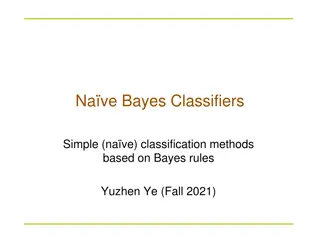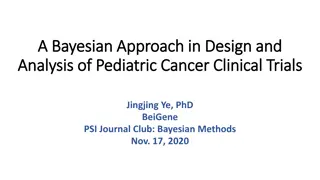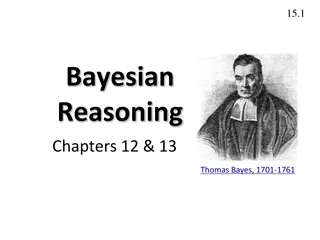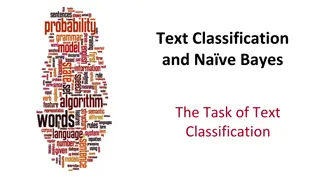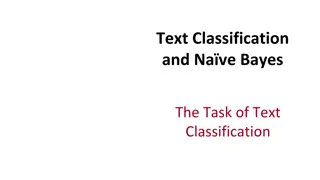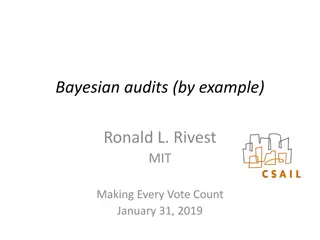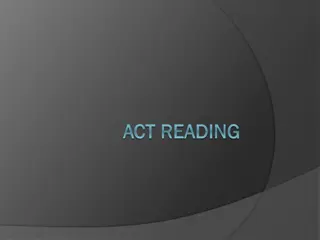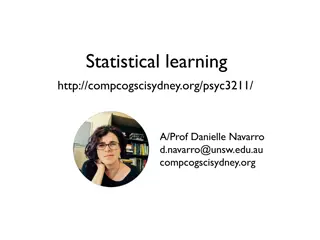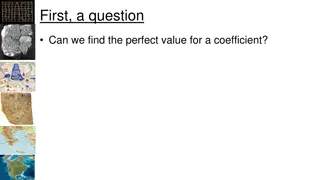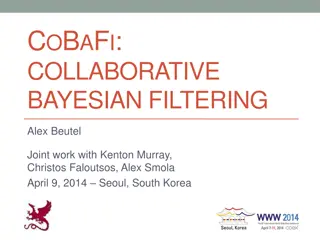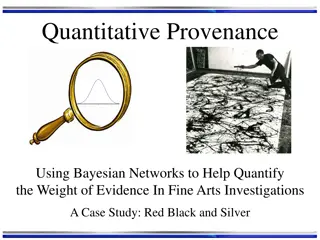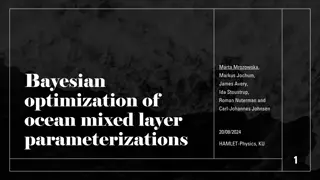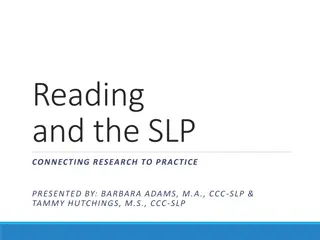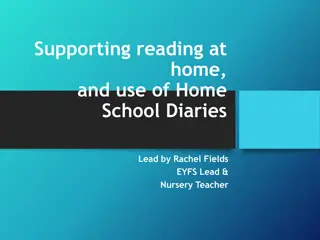Classifying Reading Passages into Categories with Naive Bayesian
Text classification involves assigning reading passages to predefined categories for purposes like spam detection, authorship identification, and sentiment analysis. This process includes document pre-processing, feature indexing, applying classification algorithms, and performance measurement. Pre-processing steps such as removing stop words and stemming words are crucial. Various classification methods exist, including manual classification, hand-coded rule-based classifiers, and supervised learning like Naive Bayes and k-Nearest Neighbors. Supervised learning methods require training data labeled with fixed classes to build classifiers. While Naive Bayes is simple and common, k-Nearest Neighbors is powerful, and Support-vector machines are generally more powerful. Commercial systems often use a combination of these methods.
Download Presentation

Please find below an Image/Link to download the presentation.
The content on the website is provided AS IS for your information and personal use only. It may not be sold, licensed, or shared on other websites without obtaining consent from the author.If you encounter any issues during the download, it is possible that the publisher has removed the file from their server.
You are allowed to download the files provided on this website for personal or commercial use, subject to the condition that they are used lawfully. All files are the property of their respective owners.
The content on the website is provided AS IS for your information and personal use only. It may not be sold, licensed, or shared on other websites without obtaining consent from the author.
E N D
Presentation Transcript
Nave Bayesian How to classify reading passages into predefined categories ASH
Text Classification Assigning subject categories, topics, or genres Spam detection Authorship identification Age/gender identification Language Identification Sentiment analysis And so on..
Process Document Pre-processing Feature/indexing Applying classification algorithm Performance measure Feature filtering
Pre-processing Documents Removal of Stop words Stemming words Pre-processed data
Classification Methods (1) Manual classification Used by the original Yahoo! Directory Accurate when job is done by experts Consistent when the problem size and team is small Difficult and expensive to scale Means we need automatic classification methods for big problems
Classification Methods (2) Hand-coded rule-based classifiers Commercial systems have complex query languages Accuracy is can be high if a rule has been carefully refined over time by a subject expert Building and maintaining these rules is expensive
Classification Methods (3): Supervised learning Given: A document d A fixed set of classes: C = {c1, c2, , cJ} A training set D of documents each with a label in C Determine: A learning method or algorithm which will enable us to learn a classifier For a test document d, we assign it the class (d) C
Classification Methods (3) Supervised learning Naive Bayes (simple, common) k-Nearest Neighbors (simple, powerful) Support-vector machines (new, generally more powerful) plus many other methods No free lunch: requires hand-classified training data But data can be built up (and refined) by amateurs Many commercial systems use a mixture of methods
What is the Nave Bayes Classifier? A simple probabilistic classifier which is based on Bayes theorem with strong and na ve independence assumptions. Assumption features used in the classification are independent Despite the na ve design and oversimplified assumptions that this technique uses, Na ve Bayes performs well in many complex real-world problems.
When to use the Nave Bayes Text Classifier? It is less computationally intensive and requires a small amount of training time. When you have limited resources in terms of CPU and Memory. Moreover, when the training time is a crucial factor. Keep in mind that the Na ve Bayes classifier is used as a baseline in many researches.
Bayes Rule Applied to Documents and Classes For a document d and a class c
Naive Bayes Classifiers Task: Classify a new instance D based on a tuple of attribute values into one of the classes cj C x x D , , , 2 1 = = nx argmax c j ( | , , , ) c P c x x x 1 2 MAP j n C ( , P , , | ) ( ) P x x x c P c 1 2 n j j = argmax c j ( , , , ) x x x C 1 2 n = argmax c j ( , , , | ) ( ) P x x x c P c 1 2 n j j C MAP = Maximum Aposteriori Probability 12
Underflow Prevention: log space Multiplying lots of probabilities, which are between 0 and 1, can result in floating-point underflow. It will be rounded to zero, and our analyses will be useless. Class with highest final un-normalized log probability score is still the most probable. Note that model is just max of sum of weight = j C c j positions + argmax log ( ) log ( | ) c P c P x c NB i j i 13
The Nave Bayes Classifier 1) Conditional Independence Assumption: Features (term presence) are independent of each other given the class: ) | ( ) | , , ( 1 5 1 C X P C X X P = ( | ) ( | ) P X C P X C 2 5 2) Position Independence Assumption: Word appearance does not depend on position ) | ( c w X P i = For all positions i, j, word w, and class c = = ( | ) P X w c j 14
Learning the Model maximum likelihood estimates simply use the frequencies in the data = C ( ) N c P ( j = ) c j N = = ( , ) N X x C c ( P i i = j = | ) x c i j ( ) N C c j 15
Problem with Max Likelihood = ( , , | ) ( | ) ( | ) ( | ) P X X C P X C P X C P X C 1 5 1 2 5 What if a particular feature/word does not appear in a particular class? P(X5=t |C =nf)=N(X5=t,C =nf) =0 N(C =nf) To avoid this, we will use Laplace smoothing by adding 1 to each count: X N c x P j i = ) | = = ) + ( , ) 1 x C c ( i i j = + C ( N c k j # of terms contained in the vocabulary j 16
Nave Bayes: Learning Algorithm From training corpus, extract Vocabulary Calculate required P(cj)and P(xk | cj)terms For each cj in Cdo docsj subset of documents for which the target class is cj | | ) ( j c P docs j | documents # total | Textj single document containing all docsj for each word xkin Vocabulary nk number of occurrences ofxkin Textj + n ( | ) k P x c k j + | | n Vocabulary 17
Nave Bayes: Classifying Return cNB, where positions = argmax ( ) ( | ) c P c P x c NB j i j c C i j Positions all word positions in current document which contain tokens found in Vocabulary 18
Two Models Model 1: Multivariate Bernoulli ( w t X P = = fraction of documents of topic cj in which word w appears | ) c j Used when in our problem the absence of a particular word matters. Ex) Spam or Adult Content Detection Hold 1st assumption of Na ve bayesian 19
Two Models Model 2: Multinomial = Class conditional unigram ( j i c w X P fraction of times in which word w appears across all documents of topic cj = = | ) Used when the multiple occurrences of the words matter a lot in the classification problem. Ex) Topic classification Hold 1st and 2nd assumption of Na ve Bayesian Use same parameters for each position Result is bag of words model (over tokens not types) 20
The bag of words representation ( I love this movie! It's sweet, but with satirical humor. The dialogue is great and the adventure scenes are fun It manages to be whimsical and romantic while laughing at the conventions of the fairy tale genre. I would recommend it to just about anyone. I've seen it several times, and I'm always happy to see it again whenever I have a friend who hasn't seen it yet. )=c Na ve Bayes relies on Bag of words representation
The bag of words representation: using a subset of words
The bag of words representation great love 2 2 ( )=c recommend 1 laugh happy 1 1 ... ...
Bag of words for document classification
Feature Selection: Why? Text collections have a large number of features 10,000 1,000,000 unique words and more Feature Selection Makes using a particular classifier feasible Some classifiers can t deal with 100,000 of features Reduces training time Training time for some methods is quadratic or worse in the number of features Can improve generalization (performance) Eliminates noise features 25
Feature selection: how? Two ideas: Chi-square test ( 2) Test whether the occurrence of a specific term and the occurrence of a specific class are independent. Clear information-theoretic interpretation May select rare uninformative terms Mutual information (MI) How much information does the value of one categorical variable give you about the value of another Statistical foundation May select very slightly informative frequent terms that are not very useful for classification They re similar, but 2 measures confidence in association, (based on available statistics), while MI measures extent of association (assuming perfect knowledge of probabilities) 26
Feature Selection: Frequency The simplest feature selection method: Just use the commonest terms No particular foundation But it make sense why this works They re the words that can be well-estimated and are most often available as evidence In practice, this is often 90% as good as better methods
Example The denominators are (8 + 6) and (3 + 6) because the lengths of textcand are 8 and 3, respectively, and because the constant B is 6 as the vocabulary consists of six terms.
Example Thus, the classifier assigns the test document to c = China. The reason for this classification decision is that the three occurrences of the positive indicator CHINESE in d5 outweigh the occurrences of the two negative indicators JAPAN and TOKYO.
Evaluating Categorization Evaluation must be done on test data that are independent of the training data Sometimes use cross-validation (averaging results over multiple training and test splits of the overall data) Measures: precision, recall, F1, classification accuracy Classification accuracy: r/n where n is the total number of test docs and r is the number of test docs correctly classified
Experiment Training data: 13188 sets Category: Science or Humanity (Binary) or Science, Humanity, Social-science, Art, Business (5 categories) Test data: Using 10-fold method (K-fold)
Two category Classifiers NB RBF network Bagging ZeroR Random Forest Lib SVM Accuracy 92.49% 59.32% 92.34% 56.25% 90.47% 94.85% Precision 92.9% 58.5% Recall 92.5% 59.3% 92.3% 56.3% 90.5% 94.9% F-measure 92.5% 57.2% 92.4% 40.5% 90.5% 94.9% 92.5% 31.6% 91% 94.9% Five category Classifiers NB RBF network Bagging ZeroR Random Forest Lib SVM Accuracy 76.91% 50.08% 81.93% 50.08% 76.67% 88.61% Precision 78.5% 25.1% 81.6% 25.1% 76.2% 88.6% Recall 76.9% 50.1% 81.9% 50.1% 76.7% 88.6% F-measure 76.9% 33.4% 81.6% 33.4% 75.8% 88.5%
Naive Bayes is Not So Naive Very fast learning and testing (highly efficient) Low storage requirements Robust to irrelevant(noise) features and concept drift
References http://web.stanford.edu/class/cs124/lec/naivebay es.pdf http://research.ijcaonline.org/volume68/number17 /pxc3887301.pdf http://blog.datumbox.com/machine-learning- tutorial-the-naive-bayes-text-classifier/
